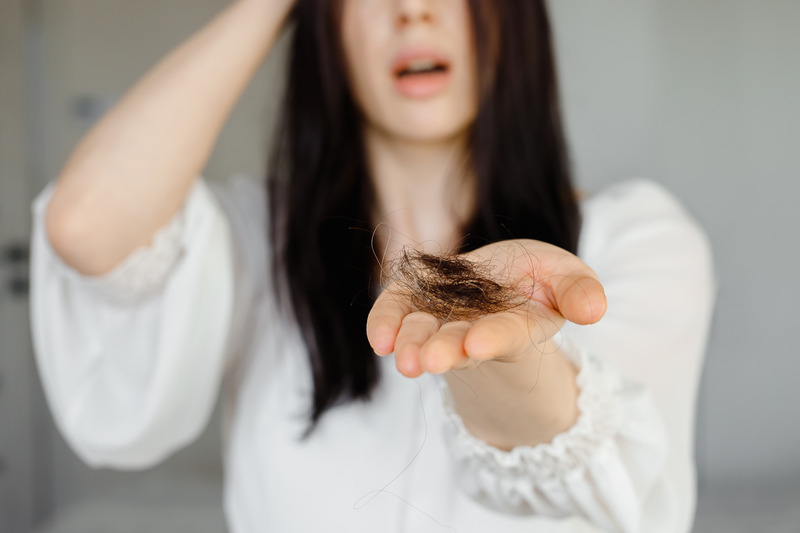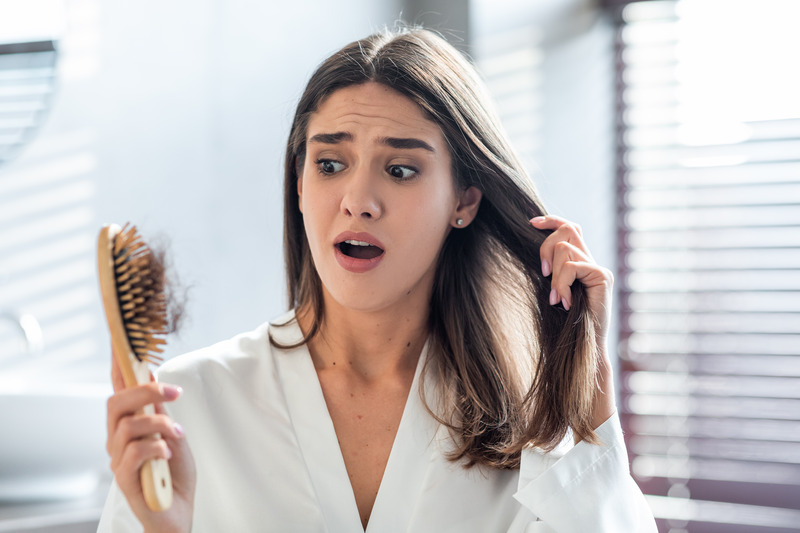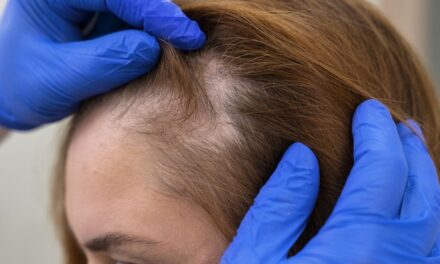
Hair loss is a widespread issue that affects many, stemming from various factors such as genetics, hormonal changes, stress, and certain medical conditions. Amidst these causes, a lesser-known yet significant factor is hair styling.
Traction alopecia, a form of hair loss, arises due to the constant pulling on the hair from tight hairstyles, shedding light on how our haircare routines can inadvertently contribute to hair loss. This condition emphasizes the need for awareness about the delicate balance between hair styling and hair health, urging a reconsideration of our daily haircare practices.
What is Traction Alopecia?
Traction alopecia, a type of hair loss, results from hair tightly pulled by certain hairstyles, putting strain on the follicles and leading to eventual damage and loss. This condition evolves slowly as hair tightly pulled styles like ponytails, braids, or weaves are used regularly, stressing the follicles.
This stress can trigger inflammation, weakening the hair and increasing susceptibility to breakage and loss, potentially resulting in bald patches over time.
Signs and Symptoms of Traction Alopecia

Traction alopecia results from certain hairstyling habits that apply continuous pressure on hair follicles, leading to hair loss over time. Recognizing the early signs and symptoms is crucial for preventing further damage and potentially reversing the condition.
Below are the key indicators to watch out for:
Early Signs of Traction Alopecia:
- Scalp pain indicates that hairstyles may be too tight and cause undue stress on hair follicles.
- Itchiness is a reaction to the strain or potential inflammation of the scalp under constant tension.
- Broken hairs around the hairline, a common issue where the tension from hairstyles like tight ponytails or braids is most noticeable, can indicate stress on the scalp.
More Severe Symptoms:
- Noticeable hair thinning, especially in areas where the hair is habitually pulled the tightest.
- The presence of areas of baldness indicates that hair loss has advanced, necessitating immediate actions to prevent permanent hair loss and further harm.
Hairstyles That Can Lead to Hair Loss
Certain hairstyles are more likely to cause traction alopecia. These include:
Tightly Pulled Ponytails
When hair is habitually styled into tightly pulled ponytails, it places significant tension on the hairline and scalp, leading to a tightly pulled hair stinging sensation. This ongoing pressure can weaken hair follicles, interrupt hair growth, and eventually cause hair loss, mainly where the tight ponytail exerts the most strain.
By choosing looser hairstyles and lessening the use of tight ponytails, one can lower this risk and aid in preserving scalp health.
Buns
Buns, when styled tightly and worn often, can place excessive pressure on the hair follicles. This ongoing tension endangers the hair shafts, potentially leading to their damage and the weakening and loss of hair follicles over time.
Choosing looser buns and frequently altering one’s hairstyle to spread the tension more uniformly across the scalp is recommended to avert such hair-pulled-related issues.
Cornrows
Cornrows involve braiding the hair close to the scalp, which can pull on both the hair and scalp, generating tension that may lead to hair loss if worn for prolonged periods. Although cornrows and similar tightly braided hairstyles hold cultural significance and visual appeal, it’s crucial to ensure they are not overly tight and to allow the hair periodic breaks from such styles to prevent traction alopecia.
By managing the tightness and giving the hair shaft a rest, one can minimize the risk of starting to lose hair due to constant strain.
Dreadlocks
Dreadlocks are not detrimental to hair health; however, complications may arise when pulled tightly or not cared for correctly. Tight dreadlocks can strain the scalp excessively, inducing tension that might weaken hair follicles and lead to hair loss.
Proper maintenance and ensuring that dreadlocks are not excessively tight can help avert this tension and maintain scalp wellness.
Hair Extensions
Incorporating artificial hair through extensions adds extra weight and tension to natural hair follicles, which can be particularly damaging if the extensions are attached too tightly. This additional strain can weaken the hair follicles and, eventually, cause hair loss, highlighting the importance of using extensions judiciously and ensuring they are applied with care to minimize damage.
Weaves
Weaves involve sewing hair wefts onto tightly braided natural hair, which can place significant tension on the scalp due to the tight braids and added weight of the weaves. This constant pull on the scalp can risk the development of traction alopecia, especially with prolonged wear.
Monitoring the tension applied and giving scalp breaks between weaves is crucial to mitigate the risk of hair loss.
Prevention Strategies

Adopting preventative strategies can significantly reduce the risk of developing traction alopecia, a form of hair loss attributed to the constant pulling from tight hairstyles. By making mindful changes in how we style our hair, we can protect our scalp and hair follicles from unnecessary strain.
Here are some effective prevention strategies:
- Vary Your Hairstyles: Regularly changing your hairstyles can alleviate the constant tension on specific areas of your scalp, allowing your hair and scalp to recover from stress or damage.
- Loosen Your Hairstyles: Opt for looser hairstyles that do not pull on the scalp. This simple adjustment can significantly reduce the risk of traction alopecia.
- Use Gentle Hair Accessories: Swap out tight, damaging hair accessories for softer, more hair-friendly options like soft hair ties and clips that minimize stress on your hair.
- Avoid Tight Styles Overnight: Sleeping in tight hairstyles can increase the tension in your hair for prolonged periods. Choose loose styles while sleeping to give your scalp a rest.
Alternative Hairstyling Tips
Exploring alternative hairstyling methods is crucial in preventing traction alopecia, ensuring that fashion does not come at the expense of hair health. By opting for styles that minimize scalp tension, you can maintain both style and the well-being of your hair.
Here are some hair-friendly styling tips:
- Opt for Loose Braids: Loosely tied braids look chic and reduce the strain on hair follicles, helping to prevent hair damage and loss.
- Choose Low Ponytails: A low ponytail exerts less pull on the hairline and can be a stylish, safer alternative to high, tight ponytails.
- Use Clips Instead of Elastic Bands: Clips can secure your hair without the damaging tension caused by elastic bands, offering a gentle way to style your hair.
- Invest in Quality Hair Care Products and Accessories: Selecting the right products and accessories designed to minimize hair damage can significantly contribute to the overall health of your hair. Look for gentle items on the hair and scalp, such as satin scrunchies, wide-tooth combs, and nourishing hair products.
Bottom Line
Being mindful of how you style your hair is crucial for preventing hair loss. If you’re experiencing symptoms of traction alopecia, consider changing your hairstyling habits and seek professional advice.
And for those looking to support their hair’s health, consider Vitamins Revive for fast hair growth. Your hair deserves care and attention, so let’s start giving it the love it needs today!
By understanding the impact of our hairstyling choices and adopting healthier habits, we can maintain our hair’s health and avoid the pitfalls of traction alopecia.
Remember, your hair’s beauty starts with its health; small changes can lead to significant improvements.
FAQs
Can hairstyles cause hair loss?
Yes, hairstyles that pull tightly on the hair can cause traction alopecia, a form of hair loss.
Which hairstyle causes less hair fall?
Loose hairstyles that do not pull on the hair are less likely to cause hair fall.
Can a haircut cause hair fall?
A haircut doesn’t cause hair fall; over-styling or incorrect styling post-cut can lead to breakage and hair loss.










